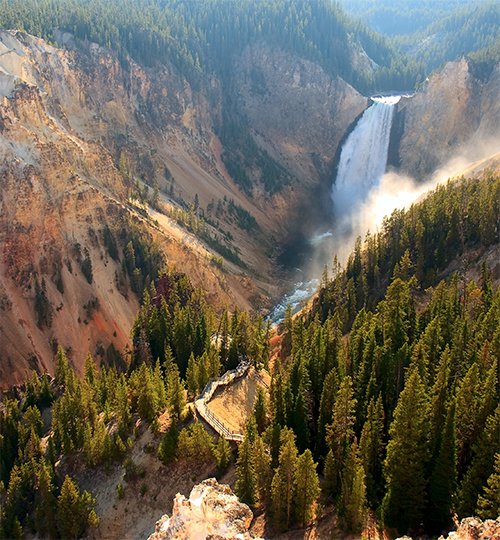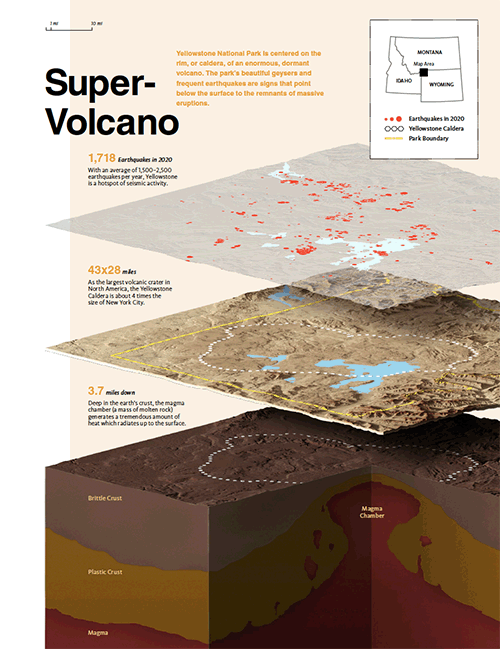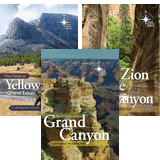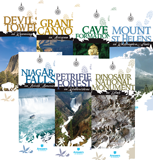Yellowstone
Beneath the surface of Yellowstone’s beauty lie fearful clues to the past—and a possible future.
When you picture Yellowstone National Park, you probably don’t envision lines of cars and crowds of people. But this past summer, after a year of quarantine and remote work, millions of visitors waited in lines for hours to find a parking space and to survey the dramatic landscape that makes this park’s natural beauty so alluring.
Yellowstone was the United States’ first national park, founded in 1872. It stretches into three states (Wyoming, Montana, and Idaho), and sprawls across 3,468.4 mi.2 (8,983 km2). That’s an area larger than Rhode Island and Delaware combined. Within the park’s expansive borders, the spread of breathtaking wilderness flaunts some impressive features.
Yellowstone hosts birds, such as sandhill cranes and eagles, as well as 67 known mammal species, including wolves, elk, bears, porcupines, and the largest herd of bison on public land. And that’s not the only record Yellowstone can claim.
The park’s largest body of water has an area of 136 mi.2 (352 km2) and a depth of 400 feet (120 m). Known as Yellowstone Lake, it is the largest high-elevation lake in North America.
Across the park, roughly 290 waterfalls cascade from towering precipices of the Rocky Mountains. The landscape also boasts two colorful canyons, the Grand Canyon of the Yellowstone and the Black Canyon of the Yellowstone, both carved by the Yellowstone River in its journey north.
Still, with all those magnificent sights, visitors wait in line the longest to see fountains of hot steam and water. With around 465 active geysers each year, Yellowstone holds well over half of the world’s geysers and hot volcanic water features, such as the vibrantly colored Grand Prismatic Spring. The Grand Geyser (the world’s tallest predictable geyser) and the Giant Geyser (one of the world’s largest geysers) erupt along with the most famous gusher, Old Faithful, which consistently spews a high fountain of hot water and steam approximately every 90 minutes.

Guests gather around Old Faithful, the world’s tallest predictable geyser.
Yellowstone is, by all accounts, a magnificent place. But perhaps the most breathtaking—and fearful—attribute lies beneath the park itself. Much of Yellowstone is positioned on the enormous craters of several volcanoes—one of them the largest in North America. Every so often, news headlines predict an eruption, warning that the ginormous mass of ash and lava would spell certain disaster for North America. The documentary Yellowstone Supervolcano: American Doomsday claims, “Yellowstone is a disaster waiting to happen with the power to change the face of the earth. . . . It will be a global catastrophe . . . and bring the world to a standstill.”
What are we to make of such dire warnings of catastrophe?
Yellowstone’s geysers and craters provide a fascinating link back to the global flood cataclysm described in Genesis 6–9. They also tell us what the earth was like in the early post-flood period. By looking at this geology from a biblical view of earth history, we can learn much about the past and even future of the Yellowstone area—including whether we should be concerned about the next big volcanic eruption.

The Yellowstone River plummets over the Lower Falls in Yellowstone’s Grand Canyon.
Past Yellowstone Eruptions
Why are there so many geysers in the Yellowstone area? It’s because much of the area, centered on Yellowstone Lake, is the cauldron-like crater (referred to as a caldera) of a humungous volcano. Known as the Yellowstone Caldera, the crater measures a staggering 43 by 28 miles (70 by 45 km). As the largest volcano on the North American continent with a history of huge explosive eruptions, no wonder the Yellowstone Caldera is called a supervolcano.
Fortunately, it is dormant—or seems to be. But it did erupt several times in the past, with devastating consequences. Some of the thick ash deposits have been found as far away as Texas. Had anyone been living in North America back then, they would have faced dire consequences.
Historic Eruptions

Many people recall when Mount St. Helens erupted in 1980. The ash plume from that recent eruption pales in comparison to the devastation from Yellowstone eruptions soon after the global flood.
The destruction and loss of life from the May 18, 1980, eruption of Mount St. Helens in Washington State is still a vivid memory for many who witnessed that awe-inspiring event as the earth unleashed such raw power. Yet in that eruption, Mount St. Helens only blasted out about 0.24 mi.3 (1 km3) of ash which spread over a limited local area downwind.
By comparison, at Yellowstone, about 240 mi.3 (1000 km3) of ash were explosively ejected to form the surrounding Lava Creek Tuff (a tuff is ash that has been welded by the heat into solid rock).1 However, there is evidence of an even larger volcanic collapse structure at Yellowstone. That larger and older caldera, now largely obscured by later geologic processes, was at least 60 miles (100 km) wide. Its explosion product, called the Huckleberry Ridge Tuff, formed from the eruption of an astounding 600 mi3 (2,500 km3) of ash.
The volcano appears to still be active, as evidenced by the frequent small earthquakes (that often make headlines) due to movements of molten rock far beneath the caldera. Therefore, scientists have expressed what seem to be well-founded fears of another Yellowstone super-eruption. The US Geological Survey continues to monitor the ongoing volcanic activity at Yellowstone. Yet, while no imminent eruption warning has been issued, the media regularly offer doomsday predictions in sensational headlines.
However, we need to remember that such predictions are based on a uniformitarian (evolutionary millions of years) interpretation of the earth’s history that denies a global Genesis flood cataclysm. What, then, are we to make of such dire warnings from a biblical view of earth history when we factor in the flood cataclysm?
Before we can answer that question, we need to understand what caused the Yellowstone super-eruptions.
The Cause of Yellowstone Eruptions
At considerable depth underneath every active volcano is a magma chamber, a large bulbous mass of molten rock. Under the Yellowstone Caldera, the magma chamber extends down from 3.7 miles (6 km) to almost 10 miles (~16 km). The tremendous heat emanating from the chamber circulates through the fractures, boiling the water in the rock above. This process powers the generation of the steam that jets skyward in the geysers.
However, sophisticated geophysical imaging has demonstrated that beneath this immense Yellowstone magma chamber is an inclined, broad column of scorching rock. This mantle plume (or hotspot) extends downward at least 410 miles (660 km) through the earth’s crust (the outer “skin”) and through the upper mantle.2
This is not the only known mantle plume. Another such hotspot exists under the southeastern tip of Hawaii’s big island. The copious volcanic eruptions that the hotspot has fueled have built the Hawaiian island chain as the Pacific plate moved northwestward over the top of the plume.3 These plumes are part of the earth-shaping operation of plate tectonics.4
The earth’s crust has been broken into plates that have moved relative to one another. So, for example, the eastern edge of the Nazca plate (under the eastern Pacific Ocean) is being dragged down under the western edge of the South American plate. The descending plate sinks into the mantle and causes hot mantle rock to move down and across in the mantle. When that hot mantle rock “hits” the very dense core at the bottom of the mantle, it is deflected back upward, sometimes as plumes. So on the other (western) side of the Nazca plate, molten rock is rising along the East Pacific Rise and producing a new seafloor that is forcing apart the plates on either side of it.
Just like the “track” of the Hawaiian plume can be traced back to the northwest on the Pacific plate due to the past eruptions that produced each of the Hawaiian Islands, the Yellowstone plume can be tracked back to the southwest on the North American plate because of the past eruptions it generated.5 In fact, even bigger eruptions than those at Yellowstone occurred back along that track of the plume—the McMullen Creek eruption of more than 408 mi.3 (1700 km3) and the Grey’s Landing eruption of more than 672 mi.3 (2800 km3).6
Of course, in the evolutionary millions-of-years interpretation, these plate and plume motions have occurred at today’s slow-and-gradual pace of inches per year—the rate one’s fingernails grow. Thus, evolutionists estimate, the Yellowstone super-eruptions occurred 640,000 years ago (Lava Creek) and 2.1 million years ago (Huckleberry Ridge). And those earlier super-eruptions back along the hotspot track supposedly occurred over 8 million years ago.
So how does all this fit within the biblical framework for the earth’s history?
Supervolcano

Yellowstone National Park is centered on the rim, or caldera, of an enormous, dormant volcano. The park’s beautiful geysers and frequent earthquakes are signs that point below the surface to the remnants of massive eruptions. Click the diagram to view a larger image.
When Did Yellowstone Actually Erupt?
Plate tectonics occurred catastrophically during the Genesis flood.7 The pre-flood supercontinent and ocean floor were both ruptured by “the fountains of the great deep” (Genesis 7:11). The resultant plates “sprinted” across the globe at meters per second (a fast walking pace) while devastating storm- and tsunami-driven surges of ocean waters flooded all land and dumped thousands of feet of fossil-bearing sediment layers across the former landmass, now broken into many continents.
The pre-flood ocean floor plates were also forced down into the mantle under the edges of continental plates. That caused massive movements of hot rock circulating in the mantle, producing the plumes where the hot rock upwelled. All this upheaval was occurring at the same, almost inconceivable catastrophic rate of meters per second.
However, when all the pre-flood ocean floor had sunk into the mantle, the processes and plate movements rapidly slowed down. By the time the flood ended, the plate and plume movements had decreased dramatically, though this deceleration continued into the immediate post-flood period until it eventually settled down to today’s snail’s pace.
We know this dramatic deceleration occurred because of the sizes of the Hawaiian Islands along the plume’s track. As it slowed down, the Pacific plate lingered over the hotspot, and thus more eruptions produced bigger islands. That’s why the biggest island stands where the plume is today.
In contrast, the super-eruptions along the track of the Yellowstone plume on the North American plate became progressively smaller until the most recent eruptions occurred at Yellowstone itself. And we know these were all post-flood super-eruptions because their ash was deposited on the present post-flood land surface before people migrated from Babel and then arrived in North America, maybe about 3,500 years ago.
Future Eruption: the Answer
So will there be another catastrophic, world-changing Yellowstone super-eruption? Probably not.
Because the plates and plumes decelerated after the flood, post-flood volcanic eruptions have also progressively decreased in frequency and size.8 The magma chamber beneath the Yellowstone Caldera today is still there fueling geysers, but it is essentially dormant and quietening down, in spite of the occasional tremor from moving rock, crystallizing magma, or moving fluids. The trivial movements of plates and plumes are merely a leftover from the global flood cataclysm that occurred only about 4,300 years ago. Even Hawaii’s eruptions are now much smaller.
Our confidence in the answer is based not on geology but on Scripture. Immediately after the flood, in spite of ongoing declining volcanic eruptions and other geologic activity, God promised Noah and all his descendants, including us, that “while the earth remains, seedtime and harvest, cold and heat, summer and winter, day and night, shall not cease” (Genesis 8:22). God has promised to maintain and conserve the regularity of the earth’s operation and seasons without another global catastrophe, such as a flood cataclysm that would destroy the earth and man (Psalm 104:6-9), until the final judgment by fire (2 Peter 3:7). He never lies and can be trusted to keep his promises.
The geology of Yellowstone represents the devastation in the aftermath of the recent global flood, warning us of the final judgment to come. But even while living in a sin-cursed world entirely reshaped and marred by the flood, we still enjoy the grandeur and beauty of places like Yellowstone and look forward to the unblemished splendor of heaven that awaits all who put their trust in the Lord Jesus Christ.
Answers Magazine
October–December 2021
Curious about creation but don’t know where to start? Let’s begin with the basics.
Browse Issue SubscribeFootnotes
- Robert B. Smith and R. L. Christiansen, “Yellowstone Park as a Window on the Earth’s Interior,” Scientific American 242, no. 2 (1980), pp. 104–117.
- Robert B. Smith et al., “Geodynamics of the Yellowstone Hotspot and Mantle Plume: Seismic and GPS Imaging, Kinematics, and Mantle Flow,” Journal of Volcanology and Geothermal Research 188 (2009), pp. 26–56.
- Andrew A. Snelling, “Hawaii’s Volcanic Origins—Instant Paradise,” Answers 9, no. 1 (2014), pp. 56–59: Hawaii’s Volcanic Origins—Instant Paradise | Answers in Genesis.
- Andrew A. Snelling, “Plate Tectonics—The Reality Behind a Theory,” Answers 11, no. 1 (2016), pp. 52–55: Plate Tectonics—The Reality Behind a Theory | Answers in Genesis.
- Victor E. Camp and Ray E. Wells, “The Case for a Long-Lived and Robust Yellowstone Hotspot,” GSA Today 31, no. 1 (2021), pp. 4–10.
- Thomas R. Knott et al., “Discovery of Two New Super-Eruptions from the Yellowstone Hotspot Track (USA): Is the Yellowstone Hotspot Waning?” Geology 48 (2020), pp. 934–938.
- Steven A. Austin et al., “Catastrophic Plate Tectonics: A Global Flood Model of Earth History,” Proceedings of the Third International Conference on Creationism (1994), pp. 609–612: Catastrophic Plate Tectonics: Global Flood Model of Earth History | Answers in Genesis.
- Steven A. Austin, “The Declining Power of Post-Flood Volcanoes,” Acts & Facts 27, no. 8 (1998).
Recommended Resources

Answers in Genesis is an apologetics ministry, dedicated to helping Christians defend their faith and proclaim the good news of Jesus Christ.
- Customer Service 800.778.3390
- © 2024 Answers in Genesis






